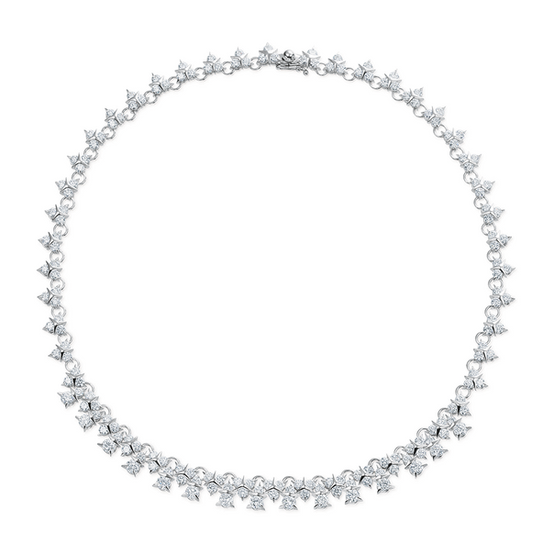The birthstone of April - 5 reasons why you might want a diamond
- pave.jewellery.budapest

- Apr 11, 2022
- 4 min read
Updated: Apr 20, 2022
The ones born in April are lucky enough to have one of our most sought-after and favourite gemstones as their own, a symbol of purity and strength: the diamond.
It is the most valued gemstone in the world due to its excellent properties: perfect shine, transparency and hardness. One of the keys to its value is that it's the hardest thing on Earth, 58x harder than any other substance found in nature, so it is no surprise that it is surrounded by such a high level of interest. A diamond can only be scratched by another diamond, doesn't wear off, which makes it durable, what is more: eternal. Its special feature is that, unlike other minerals, it consists exclusively of carbon atoms.
The passion for diamonds dates back to the 4th century BC in India. At that time, these gems were still collected from the country's rivers and streams, and by the 1400s they had become a favoured accessory for the European elite. The value of cut diamonds today can range from a few dollars to millions of dollars. Taking a 1 carat diamond as an example, the value of a high quality stone can be 20 to 25 times the value of a stone of the same size but low quality. That is why it is important to be aware of the parameters and the related value of our most precious stones, to make sure that we buy the appropriate value for money.
Factors determining the value of a diamond: the famous "4Cs"
The value of a diamond is basically determined by 4 factors, commonly referred to as “4Cs”:
Colour
The more colourless a diamond the more rare and valuable it is. The colour of a diamond generally ranges from white (or more accurately: colourless) to yellow and is defined by letters of the alphabet where D represents colourless and Z stands for yellow. Diamonds can appear in plenty of colours from red through pink to blue and green or yellow. It is difficult to define the value of these diamonds as they represent significance for collectors and individuals.
Clarity
The clarity of diamonds i.e. the level of their inclusion shall be assessed under a 10x magnification. The clearer the stone, the higher is the value. It is important to know that every diamond contains inclusions that also prove its authenticity. A stone is considered "perfectly clean" if these inclusions are not visible at 10x magnification.
Carat
Carat (ct) is the measure used for defining the weight of precious stones.
1 ct = 0,2 g (Not to be mixed up with the carat purity of gold!) The price of diamonds is usually given in carats. The carat value of diamonds grows exponentially with their carat weight, as larger stones are rarer in nature than smaller ones.
Cut
The cut of a diamond determines how effectively the stone can return light back to the viewer's eye. A well-cut diamond will appear very brilliant and fiery, while more poorly cut stones can appear dark and lifeless, regardless of colour or clarity. The brilliance of diamonds is the strongest with the brilliant (round) cut, which is based on precise measurements of the optimal light reflection of the facets. The quality of the cut depends on the variance of the angles from that of the ideal brilliant benchmark. There are also other “fancy” forms of diamond cuts, such as princess cut, pear shape or heart shape, to name just a few.
In addition to these properties, the price of a diamond is affected by other factors, such as the nature of the inclusions and the possible fluorescence of the diamond. Above a certain size, it is strongly recommended to have a credible international certificate attached to them. Be aware that it might make a big difference which institute issued the certificate.
Five reasons why you should think about investing in a diamond
If you’re still unsure why you actually need a diamond - even if you weren’t born in April - here are 5 reasons:
The value of a diamond is constantly growing: Looking at the last 100 years, we can see that the value of a diamond is constantly increasing and it is has a relatively stable value. Based on the last 12 months, for example, the value of a 1 ct G/VS1 diamond has increased by nearly 20%. *
Diamond is a relatively low-risk investment: Demand for value-added products is not expected to weaken in the future due to rising inflation risks and exchange rate fluctuations. In addition, the occasionally escalating political situations also drive investment in diamonds.
A diamond is eternal: As its Greek name (“adamas”) suggests: the diamond is indestructible. Due to the hardness of 10 on the Mohs scale, the chances of injury are very low, thus providing maximum safety for the owner.
The diamond is mobile: Diamonds hold high value, but unlike gold bars they are light in weight and require only a small space, thus are easy to carry.
"Diamonds are a girl's best friend": Diamonds are not only great value for money – a gorgeous piece of diamond jewellery can always open a lady's heart…
If you've found our argument convincing enough, we look forward to welcoming you in our store for a consultation.
*Source: Rapaport list, 23 April 2021 and 8 April 2022 (exact measure: 19.35%)
Jewellery: Garavelli Design Italy, Piero Milano, Hulchi Belluni, PAVÉ
























